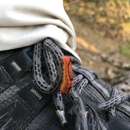Conservation Status
provided by University of Alberta Museums
Very rare and at the extreme northwestern limit of its range in northern Alberta.
- license
- cc-by-nc
- copyright
- University of Alberta Museums
Cyclicity
provided by University of Alberta Museums
The only Alberta record is an adult female collected in mid-June.
- license
- cc-by-nc
- copyright
- University of Alberta Museums
Distribution
provided by University of Alberta Museums
Nova Scotia west to northeastern Alberta, south to Florida and Texas, and in the USA west to Oregon. In Alberta, known only from a single specimen collected just north of Fort McMurray.
- license
- cc-by-nc
- copyright
- University of Alberta Museums
General Description
provided by University of Alberta Museums
A medium-size (3.5-4.0 cm wingspan) dark purple-grey moth. Forewings have a long narrow black basal streak, a larger black streak (dagger-mark) in the anal angle, and a smaller one near the apex. The postmedian-line is prominent, marked with black scales, and loops outward between the costa and the upper dagger mark, between the two dagger marks, and below the lower dagger mark. The orbicular spot is indistinct, marked by a few dark scales. The reniform spot is more prominent and is filled with dark red-brown scales. There are also dark red-brown scales shading the upper part of the lower dagger-mark. Hindwings are grey-brown, darker toward the margin. The sexes are similar, but the female is darker, especially on the hindwings. Antennae simple in both sexes. The Triton dagger-moth is darker and less patterned than the other Alberta dagger-moths. Apharetra dentata is similar in color and pattern and occurs in the same habitat, but is much smaller and flies later in the season.
- license
- cc-by-nc
- copyright
- University of Alberta Museums
Habitat
provided by University of Alberta Museums
Dry forest with blueberry understory.
- license
- cc-by-nc
- copyright
- University of Alberta Museums
Life Cycle
provided by University of Alberta Museums
A solitary defoliator of blueberry. The single annual brood overwinters in the pupal stage. Adults come to light.
- license
- cc-by-nc
- copyright
- University of Alberta Museums
Trophic Strategy
provided by University of Alberta Museums
No Alberta data; elsewhere reported to feed on various Ericaceae, including species of Vaccinium sp. (blueberry and cranberry), Azalea and Rhododendron. The Alberta specimen was taken in association with blueberry.
- license
- cc-by-nc
- copyright
- University of Alberta Museums
Acronicta tritona
provided by wikipedia EN
Acronicta tritona, the Triton dagger moth, is a moth of the family Noctuidae. The species was first described by Jacob Hübner in 1818.[1][2][3] It is found in eastern North America, from Nova Scotia west to north-eastern Alberta, south to Florida and Texas, and west to Oregon.
The wingspan is 35–40 mm.
The larva feeds on Helonias bullata and Vaccinium species, including Oxycoccos species and Vaccinium stamineum.
References
-
^ "931432.00 – 9211 – Acronicta tritona – Triton Dagger – (Hübner, 1818)". North American Moth Photographers Group. Mississippi State University. Retrieved October 21, 2020.
-
^ Beccaloni, G.; Scoble, M.; Kitching, I.; Simonsen, T.; Robinson, G.; Pitkin, B.; Hine, A.; Lyal, C., eds. (2003). "Acronicta tritona". The Global Lepidoptera Names Index. Natural History Museum. Retrieved October 21, 2020.
-
^ Savela, Markku (August 29, 2020). "Acronicta tritona (Hübner, [1813])". Lepidoptera and Some Other Life Forms. Retrieved October 21, 2020.

- license
- cc-by-sa-3.0
- copyright
- Wikipedia authors and editors
Acronicta tritona: Brief Summary
provided by wikipedia EN
Acronicta tritona, the Triton dagger moth, is a moth of the family Noctuidae. The species was first described by Jacob Hübner in 1818. It is found in eastern North America, from Nova Scotia west to north-eastern Alberta, south to Florida and Texas, and west to Oregon.
The wingspan is 35–40 mm.
The larva feeds on Helonias bullata and Vaccinium species, including Oxycoccos species and Vaccinium stamineum.
- license
- cc-by-sa-3.0
- copyright
- Wikipedia authors and editors

